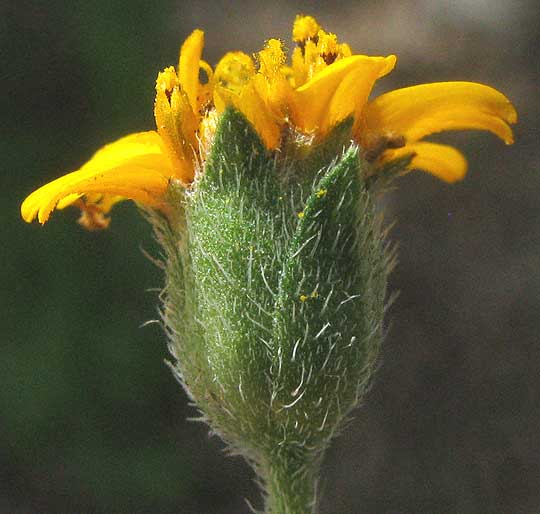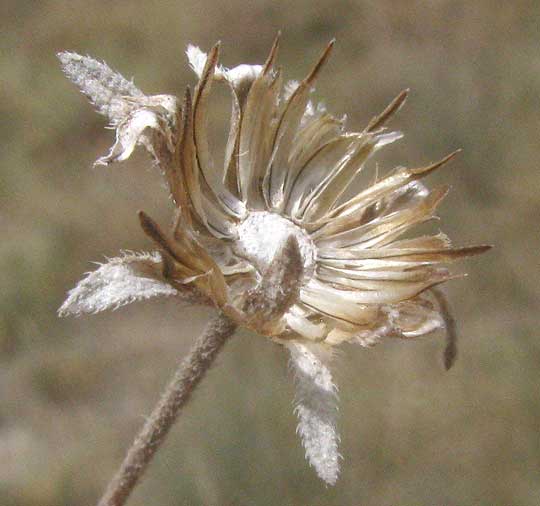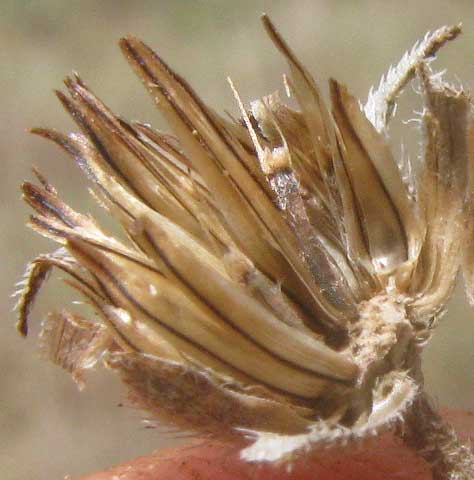Excerpts from Jim Conrad's
Naturalist Newsletter

page August 25, 2013 Newsletter issued from the Frio Canyon Nature Education Center in the valley of the Dry Frio River in northern Uvalde County, southwestern Texas, on the southern border of the Edwards Plateau; elevation ~1750m (~5750 ft); N29.62°, W99.86°; USA
WEDELIA
It's been so long since we had a good rain that the landscape has grown straw colored and where the community's road dips into the little Dry Frio River there's no water at all. Still, a few of the most drought-resistant wildflowers still can be found flowering, though even they are beginning to look scrappy.
One wildflower still blossoming is a knee-high, densely branching, perennial subshrub, a yellow-flowered member of the Composite or Sunflower Family. I've overlooked it until now because we have so many knee-high, yellow-flowered members of the Composite Family that this one just slipped past me. They've been flowering for few weeks, so most flower heads already have faded and released their cypsela-type fruits. One with a few flowering heads that still can be found is shown above.
Note the small heads atop long, stiff peduncles arising from between two simple leaves, and that the leaves are paired at stem nodes (opposite). The plant is scratchy with short hairs covering not only the stems and leaves but also the head's green involucre, as seen below:

The mature, spent heads are nearly as attention-getting as the flowers, suggesting pale, fingernail-sized little stars hovering above the plant's dense herbage. A spent head is shown below:

Some mature heads still bear some cypsela-type fruits, and that's important because the cypselae help us identify this plant. Below you can see a broken-apart fruiting head with a slender, dark brown cypsela shown a little right of center:

Atop the cypsela the pappus consists of a tiny crown of pale, almost whitish scales on both sides of which arise much taller, slender, spine-like "awns." It's much more typical for pappi to consist of a tuft of white hairs, or just the awns, or just the crown, or no pappus at all, so bearing both a crown of scales and two long awns is unusual. Also note that the cypsela is partly surrounded by a scoop-shaped bract a bit longer than the cypsela. Many genera of composite flower heads don't produce such bracts.
These and other field marks lead us to this name: WEDELIA ACAPULCENSIS, known by several book names, including Zexmenia, Orange Zexmenia, Hairy Wedelia, Texas Creeping-oxeye, and just plain Wedelia. In Texas, botanists seem to use the binomial Wedelia texana, but the online Flora of North America asserts that that name "has not been validly published."
The Flora describes Wedelia's habitat as "Damp places in otherwise dry sites, igneous or limestone derived soils, thorn woodlands, desert scrublands," and it's true that here it gathers mostly in shady spots and the bottoms of dry erosion features.
Wedelia occurs from Costa Rica north through Mexico to Texas, where it occupies about the southwestern third of the state.